- Aug 26 1:55 pm
#38942
I have posted some bird shots from my birding trip to Costa Rica in late June and early July on this forum, and I thought I'd post a few more.
In this post I'll talk about some highlights from the trip.
Seeing a Costa Rican Pygmy Owl
July 6 2013, Cerro De La Muerte, Costa Rica.
I was hiking the trails winding through forest in the Cerro De La Muerte region of Costa Rica. At around 3000 meters, hiking up and down slopes makes you really tired, but I was constantly being refueled by all the incredible birds around me. As I hiked up a slippery and steep slope, I heard some hummingbirds chattering. A Magnificent Hummingbird and a Fiery-throated Hummingbird were buzzing around over a branch. It appared that they were in some sort of territorial dispute, but whatever they were doing went on and on for minutes. I was just about to continue walking when all of a sudden a lump on a branch below the hummingbirds moved. I had hardly noticed it, as it appeared to be a lump of moss. But I put my camera on it, and there it was - a Costa Rican Pygmy Owl. You can't tell from the photo how small this owl really is, but this owl is really tiny.
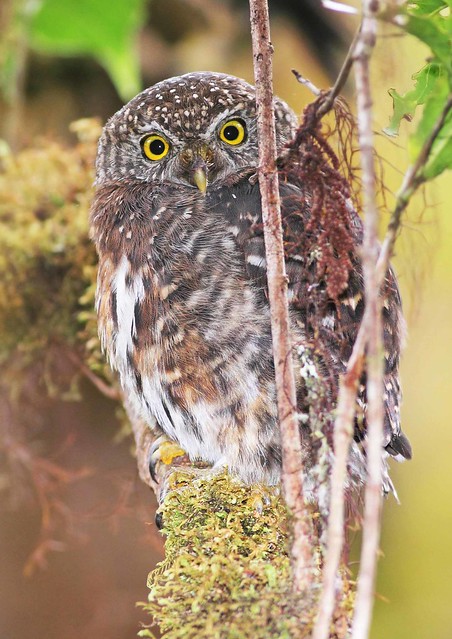
Highland Hummingbirds - Fiery-throated Hummingbirds and Magnificent Hummingbirds
July 5 and 6 2013, Cerro De La Muerte, Costa Rica.
The spectacle of tons of hummingbirds buzzing around all over the place is incredible. In the highlands of Costa Rica where I was, the majority of these birds were Fiery-throated Hummingbirds, and the second most common hummer was the Magnificent Hummingbird. These hummingbirds were everywhere and it was incredible to watch them as they buzzed around all over the place.
Magnificent Hummingbird

Fiery-throated Hummingbird
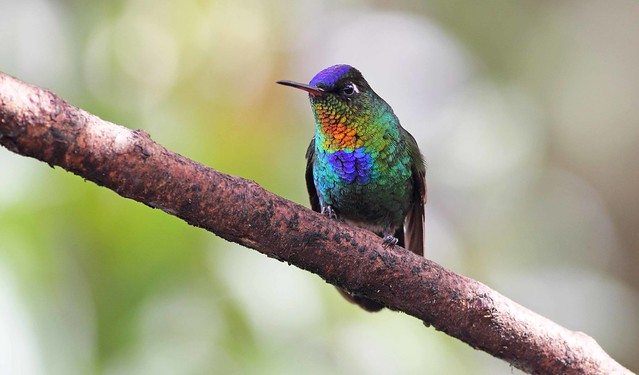
Finding a Golden-hooded Tanager nest
July 7 2013, Rancho Naturalista lodge, Costa Rica.
As I walked along the entry road of Rancho Naturalista lodge, some colour caught my eye. Then two bits of colour. When they went still, I saw what they were. Two beautiful Golden-hooded Tanagers. As I watched the birds, they both went to the same spot over and over again, and when I looked at that spot closely, I realized it was a nest they were working on. Very cool!
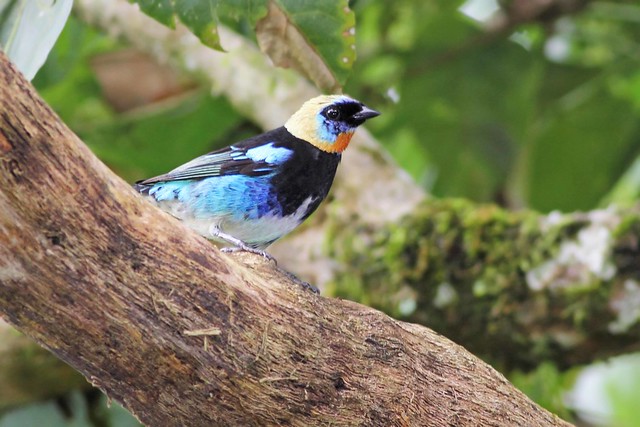
A night excursion - the Dusky Nightjar
July 5 2013, Cerro De La Muerte, Costa Rica.
When in the Cerro De La Muerte region of Costa Rica, I stayed at a lodge called Paraiso Del Quetzals. When I asked one of the staff members about night birds around the lodge, he told me where I could look for a Dusky Nightjar or two. Sure enough, two birds were present in the area he told me to look, and one bird was perching down low in between insect snacks caught on-the-fly. This provided me with some great shots! This was also the only completely clear night and the stars were amazing (see the second photo).
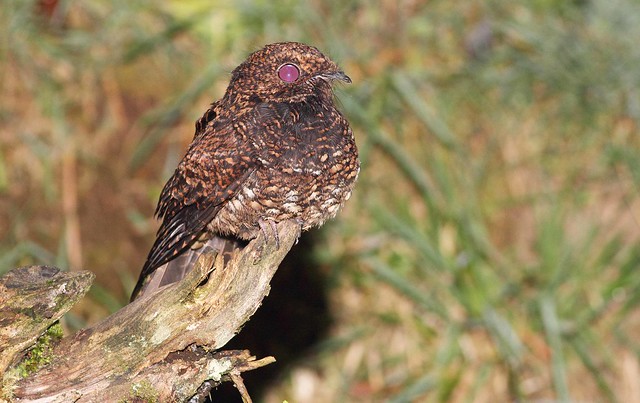
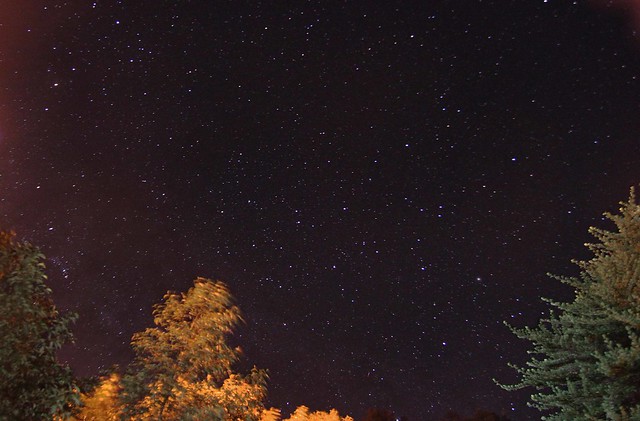
Wild raptors up close - Crested Caracara, Yellow-headed Caracara, and Black Vulture
July 3 2013, Tarcoles River, Tarcoles, Costa Rica.
Birds of prey are definitely fascinating birds to me. It was really cool to get really close-up views of Crested Caracara, Yellow-headed Caracara, and Black Vulture while on a crocodile tour on the Tarcoles River.
Crested Caracara
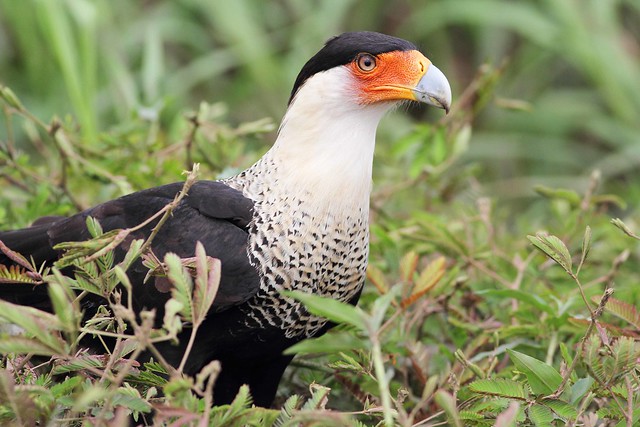
Yellow-headed Caracara

Black Vulture
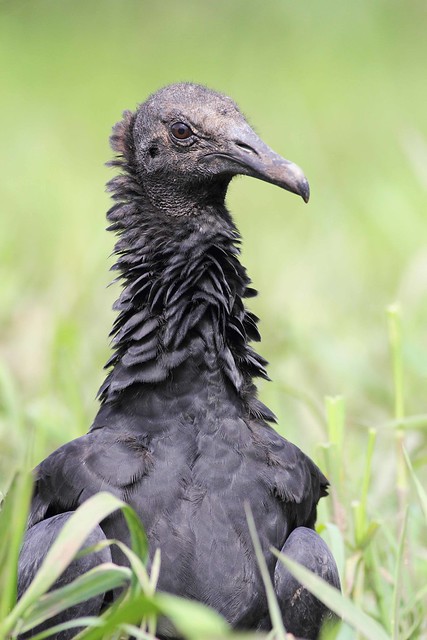
Black Vulture
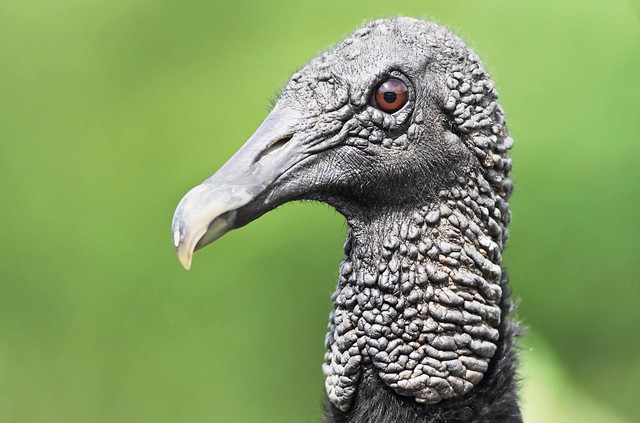
Bright Pink - Roseate Spoonbill
July 3 2013, Tarcoles River, Tarcoles, Costa Rica.
The Roseate Spoonbill is an incredible pink bird with a spoon-shaped bill. Before my Costa Rica trip, I had only seen these birds once before in Mexico flying over. Even seeing them then was amazing, but I got some really close looks on the Tarcoles River in Costa Rica. As one bird came in to land, it swooped right by the boat, so close that It didn't even fit in the whole frame. What an amazing bird and such an incredible experience seeing one so close!

Nearby was the well-named Bar-throated Tiger-Heron:

Tiny - Scintillant Hummingbird
June 30 2013, Bosque de Paz lodge, Costa Rica.
Among all the hummingbirds at Bosque de Paz lodge in the cloud forest of Costa Rica, one stood out. At first glance of this bird flying by, it appears to be an insect. But when it lands and you look at it up close, you realize that it is really at tiny little hummingbird, the Scintillant Hummingbird.
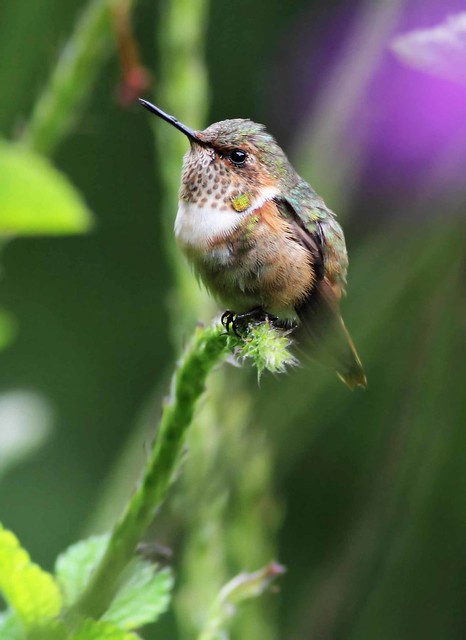
Trekking through Carara National Park - Orange-collared Manakin and Slaty-tailed Trogon
July 4 2013, Carara National Park, Costa Rica.
We arrived at Carara National Park before it opened in the morning. When we entered, we decided to hire a guide (with doubts). From that point on in the trip we realized that having a guide is really important if you want to see lots of species! With guides, we always saw more than without them because the locals really know the best sites for things. Our guide in Carara National Park, Maurice, took us around and showed us great birds. He showed as an Orange-collared Manakin lek, where the males display for females. This was really a great experience! He also led us off the main trails where he led us to a Slaty-tailed Trogon that we heard calling in the distance. Very cool, a terrific experience!
Orange-collared Manakin
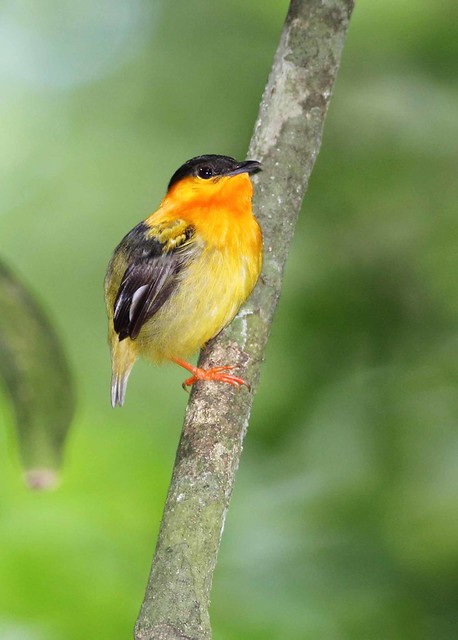
Orange-collared Manakin
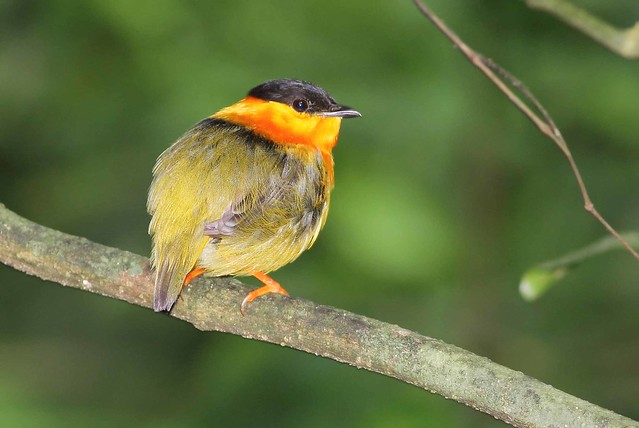
Slaty-tailed Trogon
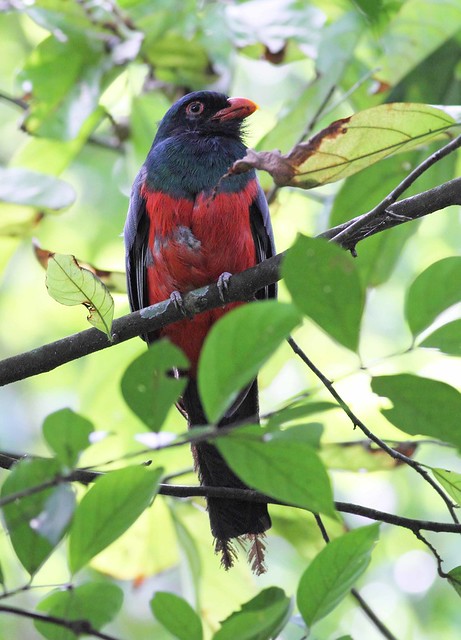
Another bird that I got some good shots of in Carara was the Chestnut-backed Antbird:

C.A.T.I.E. - Gallinules, Jacanas, Egrets, and more
July 8 2013, C.A.T.I.E., Costa Rica.
Near Rancho Naturalista lodge on the Caribbean Slope of Costa Rica, there is a lagoon on the property of a place that is some sort of school/university/lab that has to do with studying the environment (the C stands for campus). This lagoon has a breeding colony of wading birds. This colony included nesting Cattle Egrets (they made up around 90-95% of the nesting birds), Boat-billed Herons, Great Egrets, Black-crowned Night-Herons, and maybe a few other species. The marsh had other birds like Purple Gallinules, Green Herons, and Northern Jacana that were also very cool to watch.
Northern Jacana
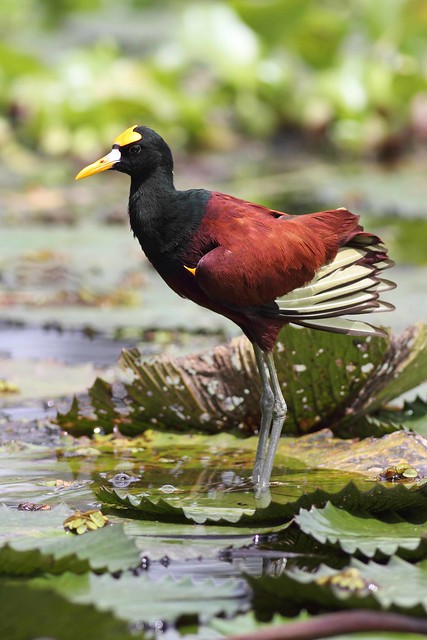

Boat-billed Heron

Purple Gallinule

Great Egret
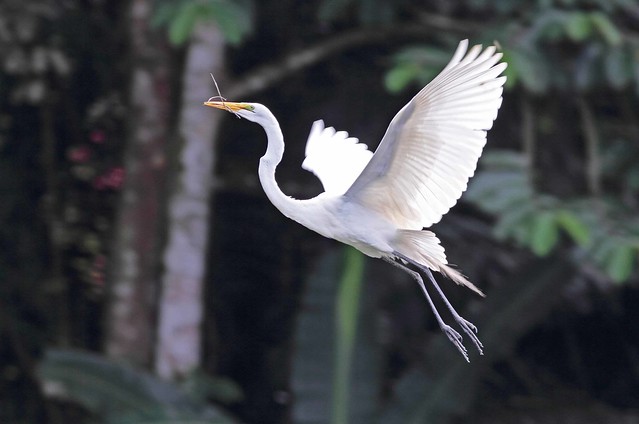
Cattle Egret

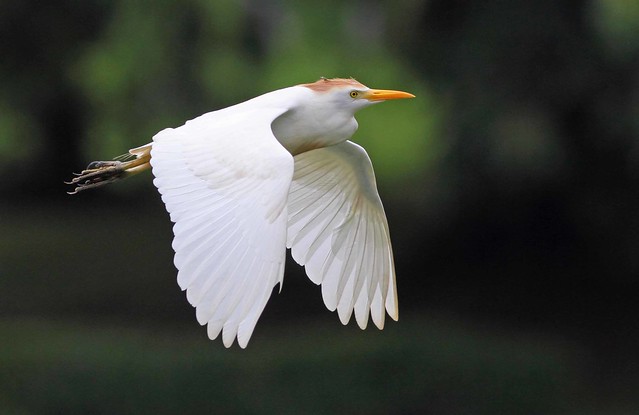
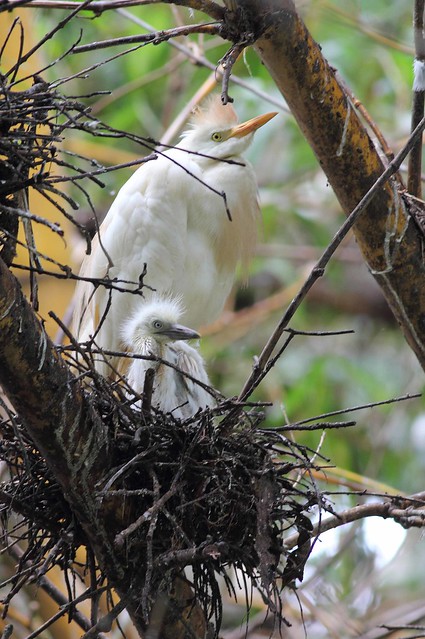
Needle in a haystack - Chestnut-headed Oropendola
July 7 2013, Rancho Naturalista, Costa Rica.
In Costa Rica, the Montezuma Oropendola is very common in many areas. As they travell around you, you can hear their songs. Among the flocks of hundreds of Montezuma Oropendolas, if you are lucky, you might pick out a Chestnut-headed Oropendola. At Rancho Naturalista lodge, I saw this guy traveling with a group of Montezuma Oropenodlas. What a cool looking bird!

Here is a shot of the common Montezuma Oropendola:

"TOUCANS!! STOP THE CAR!!" - Black-mandibled Toucan
July 1 2013, Driving between Bosque De Paz lodge and Sarapiqui, Costa Rica.
The Black-mandibled Toucan was the first toucan species we saw in Costa Rica. While driving from Bosque De Paz lodge down to the Costa Rica Nature Pavilion in Sarapiqui, We had a "pull over FAST" moment! I hopped out of the car hustled back up the road to where I had seen the birds, and took many shots. Seeing my first toucan was an incredible experience and one that I will never forget. After some shots, it was high-five time! By the end of the trip I had seen four species of toucan.
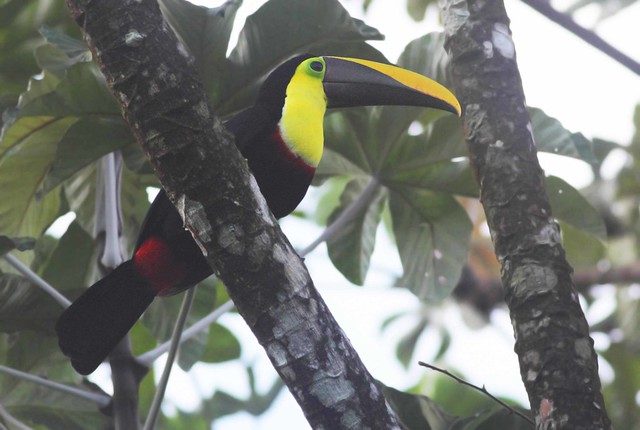
Highland fly-eaters - Black-and-yellow and Long-tailed Silky-Flycatchers
July 6 2013, Cerro De La Muerte, Costa Rica.
In the highlands, the beutiful silky flycatchers can be seen. I was lucky to get great looks of both the Black-and-yellow Silky Flycatcher and Long-tailed Silky-Flycatchers. A staff member at Paraiso Del Quetzal lodge even showed us a long-tailed Silky Flycatcher nest, which was very cool!
Black-and-yellow Silky-Flycatcher

Female Long-tailed Silky-Flycatcher on nest
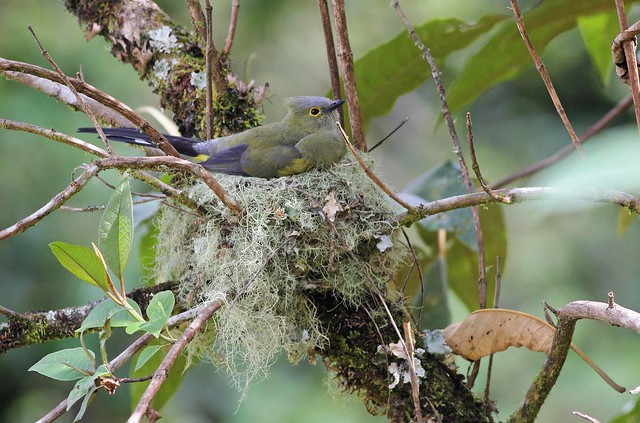
Cloud forest chickens - Black Guans
June 30 2013, Bosque De Paz, Costa Rica.
At Bosque De Paz lodge in the cloud forest of Costa Rica, Black Guans visit daily. Whether it was cold and rainy or warm and sunny, these birds could be seen. They kind of look like a cross between a crow and a vulture, but these birds and are more closely related to chickens. It was really cool to see them walking around the lodge and flying from tree to tree!
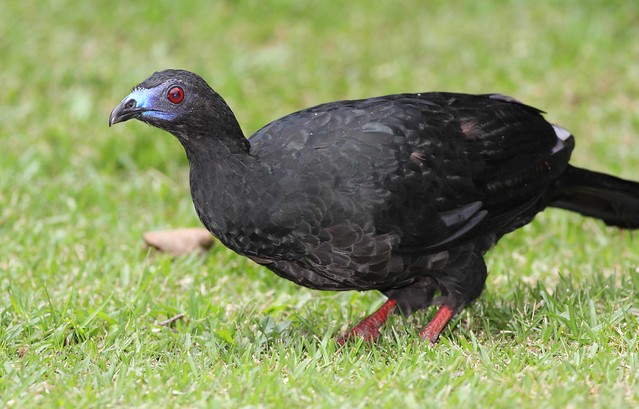

Treetop singer - Keel-billed Toucan
July 2 2013, Arenal Observatory Lodge, Costa Rica.
While staying at the foot of Arenal Volcano in the north of Costa Rica, I would walk up the entry road each morning to look for birds. This road often had the most activity out of the places we explored. For two mornings in a row, we got to see this guy perched in the same spot at the top of a tree calling for a few minutes. It was very cool! Out of all the toucans, this one has the coolest bill to me.

Two more beautiful birds that were nearby where these two tanager species:
Bay-headed Tanager:
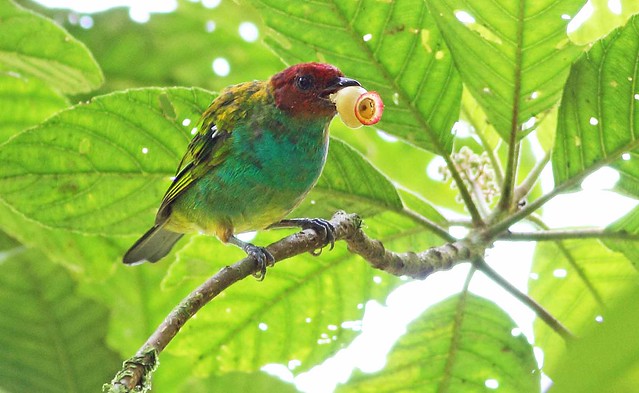
Passerini's Tanager:

Seeing two target species - Sunbittern and Snowcap
July 7 2013, Rancho Naturalista, Costa Rica.
On the first morning while staying at Rancho Naturalista lodge on the Carribean Slope of Costa Rica, we went out with a guide, Cali. Cali asked us what some species I would like to see were, and I gave him my top two targets for the location: Sunbittern, and Snowcap.
First, we went to a stream near the lodge to look for Sunbittern. The Sunbittern is a heron-like bird that is in its own family with no other species. After walking down the river, we eventually found this awesome bird.
After seeing the Sunbittern, we returned to the car and went to look for Snowcap hummingbirds. After some waiting, we got excellent views of three males feeding. It was really cool! It was a great feeling to get great looks at two of the biggest targets on the trip in one day.
Sunbittern:

Snowcap:
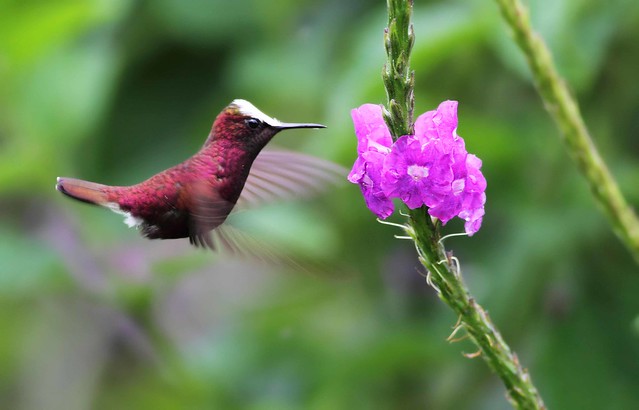
Over the stream where the Sunbittern was, this Ringed Kingfisher was perched in the rain:
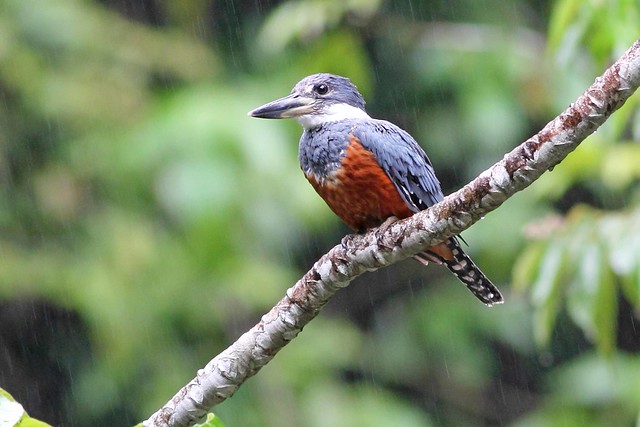
Rancho Naturalista feeder hummingbirds - Mangos, Jacobins, and more
July 6 and 7 2013, Rancho Naturalista, Costa Rica.
While staying at Rancho Naturalista lodge in Costa Rica, I did some work on getting the hummingbirds that visited the feeders in flight and in some cases, perched. i think i did pretty well in the end! It was an amazing experience seeing so many hummingbirds at once!
Green Breasted Mangos:
Female:
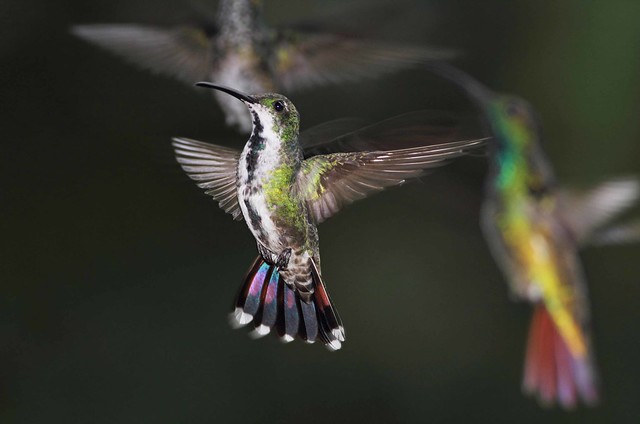
Male:
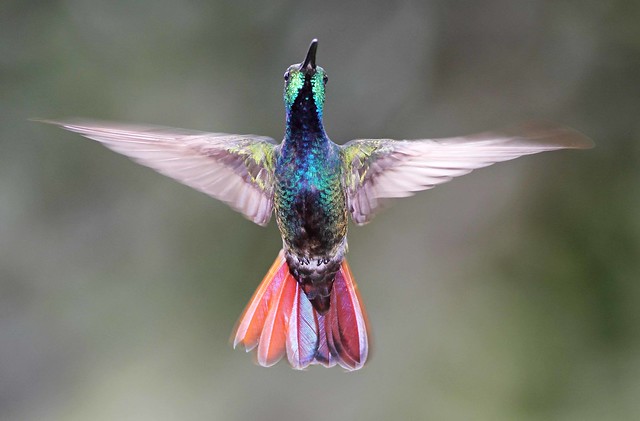
White-necked Jacobin:
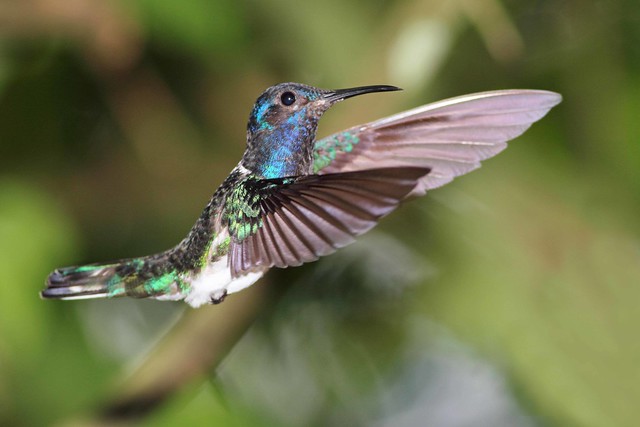
Violet-crowned Woodnymph:

Incredible colour - seeing Scarlet Macaws
July 3 2013, Tarcoles, Costa Rica.
Since I became interested in birds in 05 or 06, I have always dreamed of seeing a Scarlet Macaw in the wild. I never imagined that I would end up watching these birds in Costa Rica! In December 2012, I saw some distant Military Macaws in Mexico, but it was nothing like the experience of seeing these birds fly by in pairs. Seeing a Scarlet macaw is something that I will never forget! This macaw is one of the most incredible birds I have ever seen and seeing one was and incredible experience.
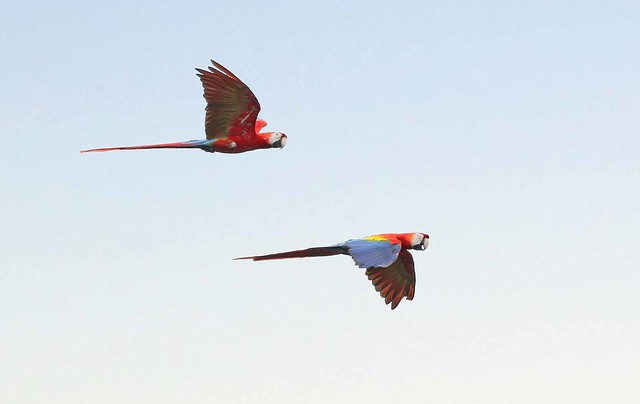
Fantastic photography opportunity - the Costa Rica Nature Pavilion
July 1 2013, Sarapiqui, Costa Rica.
In the town of Sarapiqui in Costa Rica, there is a location called the Costa Rica Nature Pavilion. This place is a must-go place for any photographers visiting Costa Rica! Toucans, Tanagers, Thrushes, and more come into feeders very close. There are also perches by the feeders that made for some great shots. The birds were very close so I was using my 70-300 IS versus the 400mm prime. It was really cool seeing so many different beautiful birds close up. The trails around the pavilion also are a hoem to many birds including Rufous Motmot and White-collared Manakin (last shot). Though I didn't see any, Great Green Macaws sometimes fly over the pavilion, and the owners hope that with some trees getting bigger the will come down and land in the years to come.
Collared Aracari
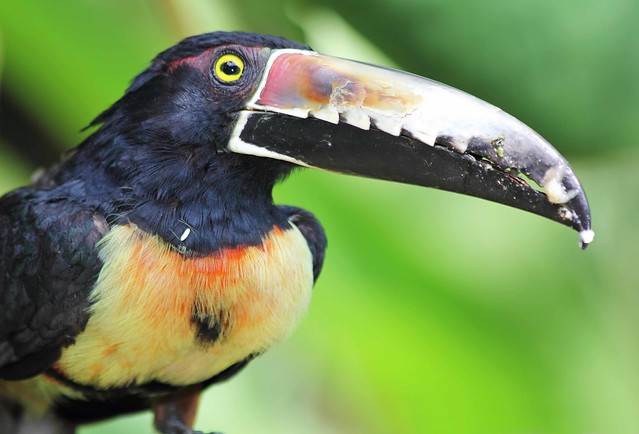
Blue-gray Tanager:

Black-cheeked Woodpecker:

Palm Tanager:

Red-legged Honeycreeper:
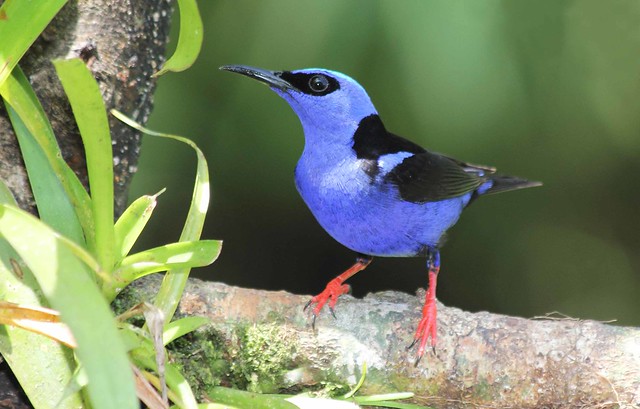
White-collared Manakin (at the beginning of the trails, not at the feeders):
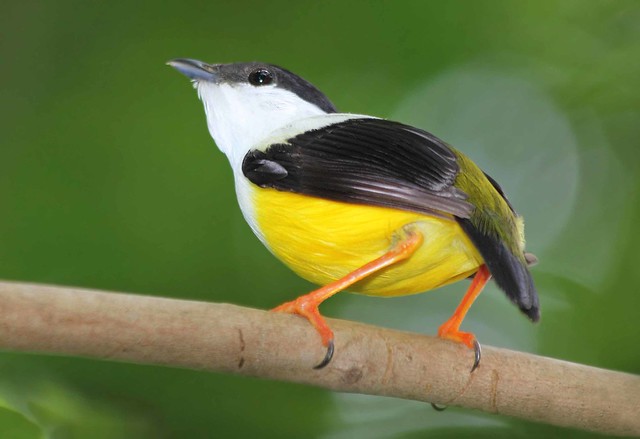
Other birds we saw at the pavilion included Bay Wren, Red-throated Ant-Tanager, Golden-hooded Tanager, Rufous Motmot, Melodius Blackbird, Social Flycatcher, Great Kiskadee, Passerini's Tanager, and more. One the trails we also saw and photographed Black and green and Strawberry Posion Dart Frogs, which was really cool, as well as Bullet Ants which have one of the most painful stings out of any insect.
Bright yellow - Silver-throated Tanager
June 30 2013, Bosque De Paz, Costa Rica.
While birding at Bosque De Paz lodge in the cloud forest of Costa Rica, I saw a pair of Silver-throated Tanagers up in the treetops. The male eventually came down low, and posed for me beautifully. Seeing such a beautiful bird so close was really incredible!

Not woodpeckers - Woodcreepers
July 2 2013, Arenal Observatory Lodge, Costa Rica.
In Costa Rica, in addition to woodpeckers, there are woodcreepers. These birds are sort of like big Brown Creepers. I saw many on the trip and a few species of them, but the shot that turned out the best was of this Streak-headed Woodcreeper at the foot of Arenal Volcano:
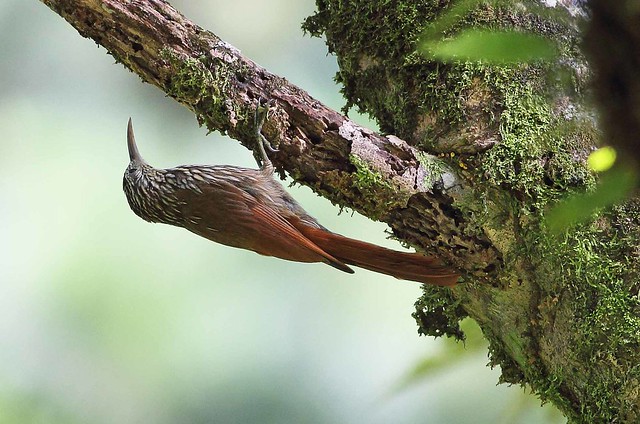
River gems - Torrent Tyrannulet and American Dipper
June 30 2013, Bosque De Paz, Costa Rica.
At Bosque De Paz lodge in Costa Rica, a stream is home to many bird species. Of the birds that live around the river, two songbirds that I enjoyed seeing and photographing were the Torrent Tyrannulet, and the American Dipper. These two birds were both special for me because the tyrannulet was a lifer (like pretty much everything), and it was the first time I had gotten some really good shots of an American Dipper.
Torrent Tyrannulet
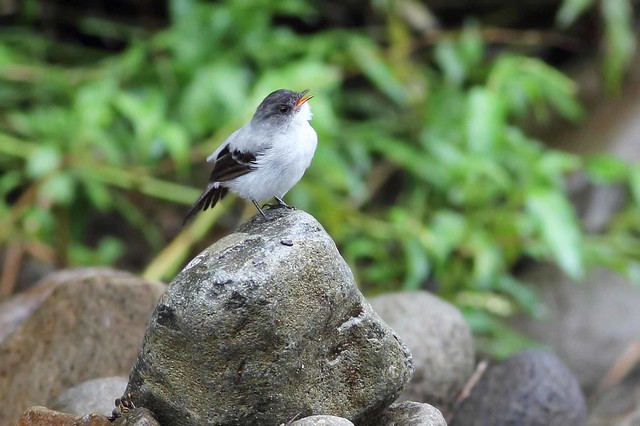
American Dipper:

Bursts of colour - Motmots
July 3 2013, Tarcoles, Costa Rica, and July 6 2013, Rancho Naturalista lodge, Costa Rica.
Motmots are one of my favorite birds, ever since I saw my first one in Mexico in December 2012. On my Costa Rica trip, I saw three species of motmot. These were the Blue-crowned Motmot, the Rufous Motmot, and the Turquoise-browed Motmot. I photographed all of these, but the bet experiences and the nicest shots went with the Blue-crowned and Turquoise-browed Motmots. All the motmots are such incredible birds though! I saw the Turquoise-browed Motmot on the banks of the Tarcoles River on the pacific coast and I saw the Blue-crowned Motmot at Rancho Naturalista lodge on the Caribbean slope.
Turquoise-browed Motmot:

Blue-crowned Motmot:
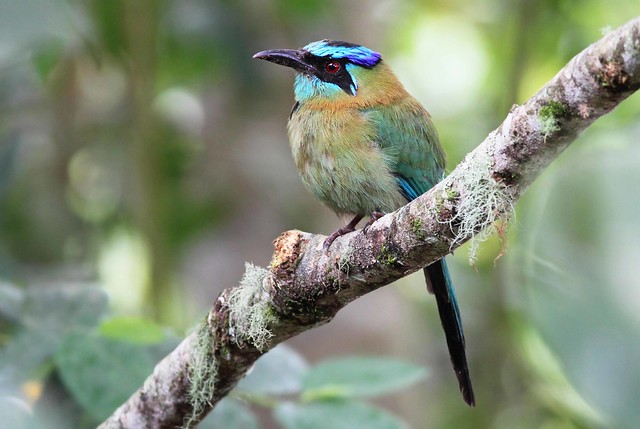
Night joy - Black-and-white Owl
July 3 2013, Cerro Lodge, Tarcoles, Costa Rica
The Black-and-white Owl is a nightly visitor at the lodge I was staying at in the Tarcoles area on the pacific coast of Costa Rica. The lodge is called Cerro Lodge, and man do they have great service! I knew that the owl comes nightly to the lodge, but I didn't know where or when it usual comes. Until the evening there was no one at the lodge who spoke English, but through google translate, I managed to have a conversation with the workers at the lodge. They showed me where the owl comes and told me when it usually comes. They said that if we want the night guard could come and get us anytime during the night if he saw the owl. We agreed, but that night the owl should up just before eight, so I got the owl and a full sleep.
It was an incredible experience to see this beautiful owl. This was the first owl I have seen at night and one of the best moments of the trip.
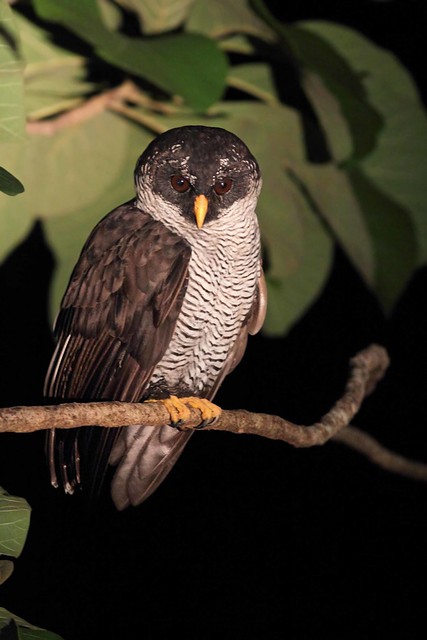
Dream come true - Resplendent Quetzal
July 6 2013, Cerro De La Muerte, Costa Rica
On my birding trip to Costa Rica in late June and July, pretty much the biggest target and hoped-for bird was the Resplendent Quetzal, a beautiful trogon of the highlands. To find this bird, I visited the Cerro De La Muerte region of Costa Rica. Cerro De La Muerte means mountain of death, but the incredible birds and scenery of this region made it seem more like the mountain of life.
The easiest time to see quetzals in Costa Rica is during the breeding season when they are very plentiful and much less shy than at other times of the year. Early July when I was looking for the quetzals is not during their breeding season so they are harder to find.
The road that goes through the Cerro De La Muerte region divides the Pacific side and the Caribbean side of the country. The lodge that I was staying at in this region was called Paraiso Del Quetzals (Quetzal Paradise), and it was on the pacific side. During the breeding season the lodge is really quetzal paradise. During most of the other times of year though, the avocados that the quetzals eat get too small around the lodge and the quetzals move to other areas.
One spot that the quetzals go to is on the Caribbean side of Costa Rica, ten kilometers from the lodge on the opposite side of the road. This spot is a small farm town with lots of fields and a tiny house or shack here and there. Surrounding the town however is forest that is full of the avocados that the quetzals love.
Paraiso Del Quetzals lodge where I was staying runs a tour to this area to try to find the quetzals. I went on the tour, and we walked up and down the hills over and over with no luck. The elevation is at about 3000 meters, and even at that elevation it gets hard to breath if you exert yourself. So walking up and down these slopes everybody was out of breath and everybody's muscles where burning. Eventually someone living in the farm town came out of his home on the farm and called to our guide. The guide said that they had spotted a quetzal in a tree. So we walked up the slope once more and just as we got to the top the quetzal flew out of the tree, over our heads into the forest.
For a first look at this bird, I was really blown away. In flight, you see the really long tail and the beautiful red and green colours. Unfortunately we couldn't relocate the bird so we eventually headed back to the lodge.
I was heading to a new site a couple hours away later in the day, so after lunch after checking out of the lodge I headed out and stopped at the farm town once again. It was the peak of afternoon which our guide said is the worst time for the quetzals, but we decided to give a "quetzal search" a go anyways.
As I got out of the car, I saw a man coming out of his home. I had been in Costa Rica long enough by now to know something: the locals know best. Even though I don't know any Spanish and I knew the man wouldn't know any English, I went up to him and said, "Quetzals?". He didn't know what I was talking about, so I played a recording of the Resplendent Quetzal and he said "ahh, Quetzaall!" He then started talking to us in Spanish and pointed to a bunch of different places. After saying "gracias" (thank you in Spanish) I decided to head in the direction of the way he pointed most often. I walked up the path and found a barbed wire fence that wasn't there in the morning. I went back down, and this time he motioned for us to follow him. He undid the barbed wire and took us up to the forest. We walked through the forest (and remember, we are at 3000 meters and there are no trails in the forest) for a long time and he checked all the avocado trees for quetzals. I was getting really tired, but then he started taking us down a slope into a clearing. After an hour and a half of walking with no trails through the forest at 3000 meters with thin air, he pointed into a tree, an there it was: a beautiful male Resplendent Quetzal feeding on avocados.
It is such an incredible bird, and it was a dream come true getting to see one. Probably the best experience and moment of the trip!
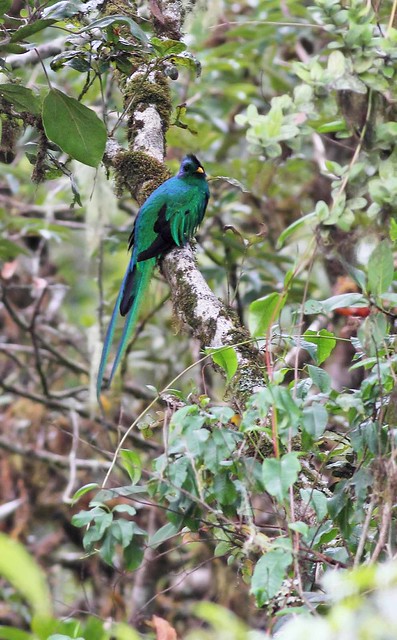
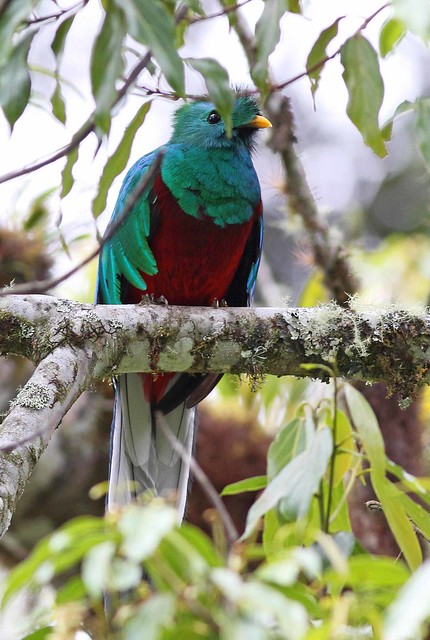
Well those are some of the top moments! There were many more, but there were way to many to post about. I didn't mention much about scenery and wildlief, but that was incredible too and you can see some of my wildlife shots and scenic shots at http://lironsnaturephotogalleries.yolas ... graphy.php (scroll down below the bird shots).
As with all my photos, prints are avialable for purchase. I have also done a photo book with all the good shots from the trip. Both prints and the photo book can be purchased at:
http://lironsnaturephotogalleries.yolas ... rchase.php
Once again, thank you for looking! And as the Costa Rican people would say, pura vida!
In this post I'll talk about some highlights from the trip.
Seeing a Costa Rican Pygmy Owl
July 6 2013, Cerro De La Muerte, Costa Rica.
I was hiking the trails winding through forest in the Cerro De La Muerte region of Costa Rica. At around 3000 meters, hiking up and down slopes makes you really tired, but I was constantly being refueled by all the incredible birds around me. As I hiked up a slippery and steep slope, I heard some hummingbirds chattering. A Magnificent Hummingbird and a Fiery-throated Hummingbird were buzzing around over a branch. It appared that they were in some sort of territorial dispute, but whatever they were doing went on and on for minutes. I was just about to continue walking when all of a sudden a lump on a branch below the hummingbirds moved. I had hardly noticed it, as it appeared to be a lump of moss. But I put my camera on it, and there it was - a Costa Rican Pygmy Owl. You can't tell from the photo how small this owl really is, but this owl is really tiny.

Highland Hummingbirds - Fiery-throated Hummingbirds and Magnificent Hummingbirds
July 5 and 6 2013, Cerro De La Muerte, Costa Rica.
The spectacle of tons of hummingbirds buzzing around all over the place is incredible. In the highlands of Costa Rica where I was, the majority of these birds were Fiery-throated Hummingbirds, and the second most common hummer was the Magnificent Hummingbird. These hummingbirds were everywhere and it was incredible to watch them as they buzzed around all over the place.
Magnificent Hummingbird

Fiery-throated Hummingbird

Finding a Golden-hooded Tanager nest
July 7 2013, Rancho Naturalista lodge, Costa Rica.
As I walked along the entry road of Rancho Naturalista lodge, some colour caught my eye. Then two bits of colour. When they went still, I saw what they were. Two beautiful Golden-hooded Tanagers. As I watched the birds, they both went to the same spot over and over again, and when I looked at that spot closely, I realized it was a nest they were working on. Very cool!

A night excursion - the Dusky Nightjar
July 5 2013, Cerro De La Muerte, Costa Rica.
When in the Cerro De La Muerte region of Costa Rica, I stayed at a lodge called Paraiso Del Quetzals. When I asked one of the staff members about night birds around the lodge, he told me where I could look for a Dusky Nightjar or two. Sure enough, two birds were present in the area he told me to look, and one bird was perching down low in between insect snacks caught on-the-fly. This provided me with some great shots! This was also the only completely clear night and the stars were amazing (see the second photo).


Wild raptors up close - Crested Caracara, Yellow-headed Caracara, and Black Vulture
July 3 2013, Tarcoles River, Tarcoles, Costa Rica.
Birds of prey are definitely fascinating birds to me. It was really cool to get really close-up views of Crested Caracara, Yellow-headed Caracara, and Black Vulture while on a crocodile tour on the Tarcoles River.
Crested Caracara

Yellow-headed Caracara

Black Vulture

Black Vulture

Bright Pink - Roseate Spoonbill
July 3 2013, Tarcoles River, Tarcoles, Costa Rica.
The Roseate Spoonbill is an incredible pink bird with a spoon-shaped bill. Before my Costa Rica trip, I had only seen these birds once before in Mexico flying over. Even seeing them then was amazing, but I got some really close looks on the Tarcoles River in Costa Rica. As one bird came in to land, it swooped right by the boat, so close that It didn't even fit in the whole frame. What an amazing bird and such an incredible experience seeing one so close!

Nearby was the well-named Bar-throated Tiger-Heron:

Tiny - Scintillant Hummingbird
June 30 2013, Bosque de Paz lodge, Costa Rica.
Among all the hummingbirds at Bosque de Paz lodge in the cloud forest of Costa Rica, one stood out. At first glance of this bird flying by, it appears to be an insect. But when it lands and you look at it up close, you realize that it is really at tiny little hummingbird, the Scintillant Hummingbird.

Trekking through Carara National Park - Orange-collared Manakin and Slaty-tailed Trogon
July 4 2013, Carara National Park, Costa Rica.
We arrived at Carara National Park before it opened in the morning. When we entered, we decided to hire a guide (with doubts). From that point on in the trip we realized that having a guide is really important if you want to see lots of species! With guides, we always saw more than without them because the locals really know the best sites for things. Our guide in Carara National Park, Maurice, took us around and showed us great birds. He showed as an Orange-collared Manakin lek, where the males display for females. This was really a great experience! He also led us off the main trails where he led us to a Slaty-tailed Trogon that we heard calling in the distance. Very cool, a terrific experience!
Orange-collared Manakin

Orange-collared Manakin

Slaty-tailed Trogon

Another bird that I got some good shots of in Carara was the Chestnut-backed Antbird:

C.A.T.I.E. - Gallinules, Jacanas, Egrets, and more
July 8 2013, C.A.T.I.E., Costa Rica.
Near Rancho Naturalista lodge on the Caribbean Slope of Costa Rica, there is a lagoon on the property of a place that is some sort of school/university/lab that has to do with studying the environment (the C stands for campus). This lagoon has a breeding colony of wading birds. This colony included nesting Cattle Egrets (they made up around 90-95% of the nesting birds), Boat-billed Herons, Great Egrets, Black-crowned Night-Herons, and maybe a few other species. The marsh had other birds like Purple Gallinules, Green Herons, and Northern Jacana that were also very cool to watch.
Northern Jacana


Boat-billed Heron

Purple Gallinule

Great Egret

Cattle Egret



Needle in a haystack - Chestnut-headed Oropendola
July 7 2013, Rancho Naturalista, Costa Rica.
In Costa Rica, the Montezuma Oropendola is very common in many areas. As they travell around you, you can hear their songs. Among the flocks of hundreds of Montezuma Oropendolas, if you are lucky, you might pick out a Chestnut-headed Oropendola. At Rancho Naturalista lodge, I saw this guy traveling with a group of Montezuma Oropenodlas. What a cool looking bird!

Here is a shot of the common Montezuma Oropendola:

"TOUCANS!! STOP THE CAR!!" - Black-mandibled Toucan
July 1 2013, Driving between Bosque De Paz lodge and Sarapiqui, Costa Rica.
The Black-mandibled Toucan was the first toucan species we saw in Costa Rica. While driving from Bosque De Paz lodge down to the Costa Rica Nature Pavilion in Sarapiqui, We had a "pull over FAST" moment! I hopped out of the car hustled back up the road to where I had seen the birds, and took many shots. Seeing my first toucan was an incredible experience and one that I will never forget. After some shots, it was high-five time! By the end of the trip I had seen four species of toucan.

Highland fly-eaters - Black-and-yellow and Long-tailed Silky-Flycatchers
July 6 2013, Cerro De La Muerte, Costa Rica.
In the highlands, the beutiful silky flycatchers can be seen. I was lucky to get great looks of both the Black-and-yellow Silky Flycatcher and Long-tailed Silky-Flycatchers. A staff member at Paraiso Del Quetzal lodge even showed us a long-tailed Silky Flycatcher nest, which was very cool!
Black-and-yellow Silky-Flycatcher

Female Long-tailed Silky-Flycatcher on nest

Cloud forest chickens - Black Guans
June 30 2013, Bosque De Paz, Costa Rica.
At Bosque De Paz lodge in the cloud forest of Costa Rica, Black Guans visit daily. Whether it was cold and rainy or warm and sunny, these birds could be seen. They kind of look like a cross between a crow and a vulture, but these birds and are more closely related to chickens. It was really cool to see them walking around the lodge and flying from tree to tree!


Treetop singer - Keel-billed Toucan
July 2 2013, Arenal Observatory Lodge, Costa Rica.
While staying at the foot of Arenal Volcano in the north of Costa Rica, I would walk up the entry road each morning to look for birds. This road often had the most activity out of the places we explored. For two mornings in a row, we got to see this guy perched in the same spot at the top of a tree calling for a few minutes. It was very cool! Out of all the toucans, this one has the coolest bill to me.

Two more beautiful birds that were nearby where these two tanager species:
Bay-headed Tanager:

Passerini's Tanager:

Seeing two target species - Sunbittern and Snowcap
July 7 2013, Rancho Naturalista, Costa Rica.
On the first morning while staying at Rancho Naturalista lodge on the Carribean Slope of Costa Rica, we went out with a guide, Cali. Cali asked us what some species I would like to see were, and I gave him my top two targets for the location: Sunbittern, and Snowcap.
First, we went to a stream near the lodge to look for Sunbittern. The Sunbittern is a heron-like bird that is in its own family with no other species. After walking down the river, we eventually found this awesome bird.
After seeing the Sunbittern, we returned to the car and went to look for Snowcap hummingbirds. After some waiting, we got excellent views of three males feeding. It was really cool! It was a great feeling to get great looks at two of the biggest targets on the trip in one day.
Sunbittern:

Snowcap:

Over the stream where the Sunbittern was, this Ringed Kingfisher was perched in the rain:

Rancho Naturalista feeder hummingbirds - Mangos, Jacobins, and more
July 6 and 7 2013, Rancho Naturalista, Costa Rica.
While staying at Rancho Naturalista lodge in Costa Rica, I did some work on getting the hummingbirds that visited the feeders in flight and in some cases, perched. i think i did pretty well in the end! It was an amazing experience seeing so many hummingbirds at once!
Green Breasted Mangos:
Female:

Male:

White-necked Jacobin:

Violet-crowned Woodnymph:

Incredible colour - seeing Scarlet Macaws
July 3 2013, Tarcoles, Costa Rica.
Since I became interested in birds in 05 or 06, I have always dreamed of seeing a Scarlet Macaw in the wild. I never imagined that I would end up watching these birds in Costa Rica! In December 2012, I saw some distant Military Macaws in Mexico, but it was nothing like the experience of seeing these birds fly by in pairs. Seeing a Scarlet macaw is something that I will never forget! This macaw is one of the most incredible birds I have ever seen and seeing one was and incredible experience.

Fantastic photography opportunity - the Costa Rica Nature Pavilion
July 1 2013, Sarapiqui, Costa Rica.
In the town of Sarapiqui in Costa Rica, there is a location called the Costa Rica Nature Pavilion. This place is a must-go place for any photographers visiting Costa Rica! Toucans, Tanagers, Thrushes, and more come into feeders very close. There are also perches by the feeders that made for some great shots. The birds were very close so I was using my 70-300 IS versus the 400mm prime. It was really cool seeing so many different beautiful birds close up. The trails around the pavilion also are a hoem to many birds including Rufous Motmot and White-collared Manakin (last shot). Though I didn't see any, Great Green Macaws sometimes fly over the pavilion, and the owners hope that with some trees getting bigger the will come down and land in the years to come.
Collared Aracari

Blue-gray Tanager:

Black-cheeked Woodpecker:

Palm Tanager:

Red-legged Honeycreeper:

White-collared Manakin (at the beginning of the trails, not at the feeders):

Other birds we saw at the pavilion included Bay Wren, Red-throated Ant-Tanager, Golden-hooded Tanager, Rufous Motmot, Melodius Blackbird, Social Flycatcher, Great Kiskadee, Passerini's Tanager, and more. One the trails we also saw and photographed Black and green and Strawberry Posion Dart Frogs, which was really cool, as well as Bullet Ants which have one of the most painful stings out of any insect.
Bright yellow - Silver-throated Tanager
June 30 2013, Bosque De Paz, Costa Rica.
While birding at Bosque De Paz lodge in the cloud forest of Costa Rica, I saw a pair of Silver-throated Tanagers up in the treetops. The male eventually came down low, and posed for me beautifully. Seeing such a beautiful bird so close was really incredible!

Not woodpeckers - Woodcreepers
July 2 2013, Arenal Observatory Lodge, Costa Rica.
In Costa Rica, in addition to woodpeckers, there are woodcreepers. These birds are sort of like big Brown Creepers. I saw many on the trip and a few species of them, but the shot that turned out the best was of this Streak-headed Woodcreeper at the foot of Arenal Volcano:

River gems - Torrent Tyrannulet and American Dipper
June 30 2013, Bosque De Paz, Costa Rica.
At Bosque De Paz lodge in Costa Rica, a stream is home to many bird species. Of the birds that live around the river, two songbirds that I enjoyed seeing and photographing were the Torrent Tyrannulet, and the American Dipper. These two birds were both special for me because the tyrannulet was a lifer (like pretty much everything), and it was the first time I had gotten some really good shots of an American Dipper.
Torrent Tyrannulet

American Dipper:

Bursts of colour - Motmots
July 3 2013, Tarcoles, Costa Rica, and July 6 2013, Rancho Naturalista lodge, Costa Rica.
Motmots are one of my favorite birds, ever since I saw my first one in Mexico in December 2012. On my Costa Rica trip, I saw three species of motmot. These were the Blue-crowned Motmot, the Rufous Motmot, and the Turquoise-browed Motmot. I photographed all of these, but the bet experiences and the nicest shots went with the Blue-crowned and Turquoise-browed Motmots. All the motmots are such incredible birds though! I saw the Turquoise-browed Motmot on the banks of the Tarcoles River on the pacific coast and I saw the Blue-crowned Motmot at Rancho Naturalista lodge on the Caribbean slope.
Turquoise-browed Motmot:

Blue-crowned Motmot:

Night joy - Black-and-white Owl
July 3 2013, Cerro Lodge, Tarcoles, Costa Rica
The Black-and-white Owl is a nightly visitor at the lodge I was staying at in the Tarcoles area on the pacific coast of Costa Rica. The lodge is called Cerro Lodge, and man do they have great service! I knew that the owl comes nightly to the lodge, but I didn't know where or when it usual comes. Until the evening there was no one at the lodge who spoke English, but through google translate, I managed to have a conversation with the workers at the lodge. They showed me where the owl comes and told me when it usually comes. They said that if we want the night guard could come and get us anytime during the night if he saw the owl. We agreed, but that night the owl should up just before eight, so I got the owl and a full sleep.
It was an incredible experience to see this beautiful owl. This was the first owl I have seen at night and one of the best moments of the trip.

Dream come true - Resplendent Quetzal
July 6 2013, Cerro De La Muerte, Costa Rica
On my birding trip to Costa Rica in late June and July, pretty much the biggest target and hoped-for bird was the Resplendent Quetzal, a beautiful trogon of the highlands. To find this bird, I visited the Cerro De La Muerte region of Costa Rica. Cerro De La Muerte means mountain of death, but the incredible birds and scenery of this region made it seem more like the mountain of life.
The easiest time to see quetzals in Costa Rica is during the breeding season when they are very plentiful and much less shy than at other times of the year. Early July when I was looking for the quetzals is not during their breeding season so they are harder to find.
The road that goes through the Cerro De La Muerte region divides the Pacific side and the Caribbean side of the country. The lodge that I was staying at in this region was called Paraiso Del Quetzals (Quetzal Paradise), and it was on the pacific side. During the breeding season the lodge is really quetzal paradise. During most of the other times of year though, the avocados that the quetzals eat get too small around the lodge and the quetzals move to other areas.
One spot that the quetzals go to is on the Caribbean side of Costa Rica, ten kilometers from the lodge on the opposite side of the road. This spot is a small farm town with lots of fields and a tiny house or shack here and there. Surrounding the town however is forest that is full of the avocados that the quetzals love.
Paraiso Del Quetzals lodge where I was staying runs a tour to this area to try to find the quetzals. I went on the tour, and we walked up and down the hills over and over with no luck. The elevation is at about 3000 meters, and even at that elevation it gets hard to breath if you exert yourself. So walking up and down these slopes everybody was out of breath and everybody's muscles where burning. Eventually someone living in the farm town came out of his home on the farm and called to our guide. The guide said that they had spotted a quetzal in a tree. So we walked up the slope once more and just as we got to the top the quetzal flew out of the tree, over our heads into the forest.
For a first look at this bird, I was really blown away. In flight, you see the really long tail and the beautiful red and green colours. Unfortunately we couldn't relocate the bird so we eventually headed back to the lodge.
I was heading to a new site a couple hours away later in the day, so after lunch after checking out of the lodge I headed out and stopped at the farm town once again. It was the peak of afternoon which our guide said is the worst time for the quetzals, but we decided to give a "quetzal search" a go anyways.
As I got out of the car, I saw a man coming out of his home. I had been in Costa Rica long enough by now to know something: the locals know best. Even though I don't know any Spanish and I knew the man wouldn't know any English, I went up to him and said, "Quetzals?". He didn't know what I was talking about, so I played a recording of the Resplendent Quetzal and he said "ahh, Quetzaall!" He then started talking to us in Spanish and pointed to a bunch of different places. After saying "gracias" (thank you in Spanish) I decided to head in the direction of the way he pointed most often. I walked up the path and found a barbed wire fence that wasn't there in the morning. I went back down, and this time he motioned for us to follow him. He undid the barbed wire and took us up to the forest. We walked through the forest (and remember, we are at 3000 meters and there are no trails in the forest) for a long time and he checked all the avocado trees for quetzals. I was getting really tired, but then he started taking us down a slope into a clearing. After an hour and a half of walking with no trails through the forest at 3000 meters with thin air, he pointed into a tree, an there it was: a beautiful male Resplendent Quetzal feeding on avocados.
It is such an incredible bird, and it was a dream come true getting to see one. Probably the best experience and moment of the trip!


Well those are some of the top moments! There were many more, but there were way to many to post about. I didn't mention much about scenery and wildlief, but that was incredible too and you can see some of my wildlife shots and scenic shots at http://lironsnaturephotogalleries.yolas ... graphy.php (scroll down below the bird shots).
As with all my photos, prints are avialable for purchase. I have also done a photo book with all the good shots from the trip. Both prints and the photo book can be purchased at:
http://lironsnaturephotogalleries.yolas ... rchase.php
Once again, thank you for looking! And as the Costa Rican people would say, pura vida!
Liron
Young birder & photographer
World Life List: 901 (seen), 921 (including heard only)
2016 BC Year List: 313 (2015: 311)
BC life list: 353
Links
Website
Flickr
Facebook
Instagram
Main photo gear
Canon 7D Mark II
Canon EF 400mm f/5.6L USM
Full list of my gear
Young birder & photographer
World Life List: 901 (seen), 921 (including heard only)
2016 BC Year List: 313 (2015: 311)
BC life list: 353
Links
Website
Flickr
Main photo gear
Canon 7D Mark II
Canon EF 400mm f/5.6L USM
Full list of my gear

 - By GMcD
- By GMcD